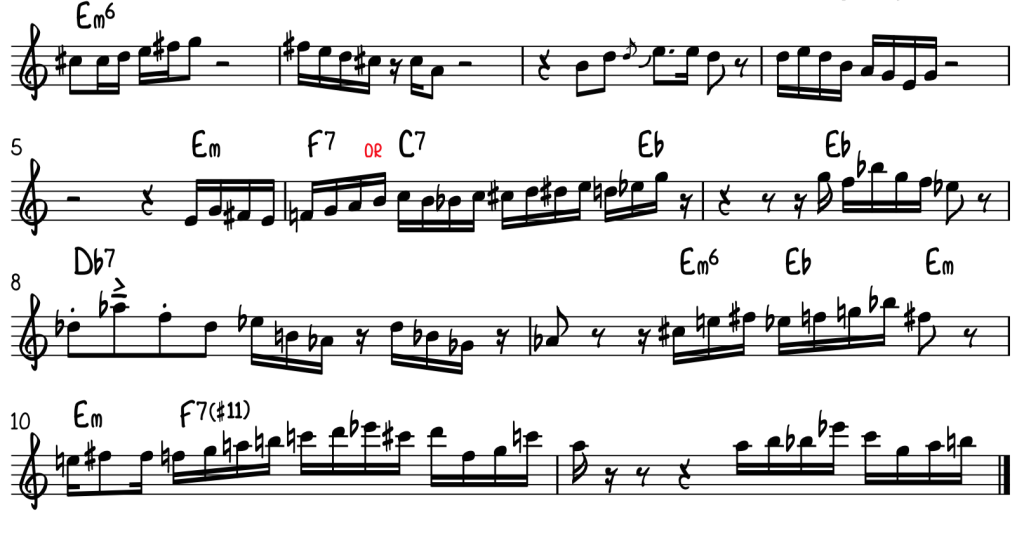 Say what you will about Roy Hargrove’s current lifestyle choices; the man has blown some serious trumpet in his day. Roy’s ability to effortlessly glide between playing “in” (playing notes that fit the harmony) and “out” (creating tension by playing notes that don’t fit) has always impressed me, so I recently decided to pick a few lines to analyze his various harmonic devices.
Say what you will about Roy Hargrove’s current lifestyle choices; the man has blown some serious trumpet in his day. Roy’s ability to effortlessly glide between playing “in” (playing notes that fit the harmony) and “out” (creating tension by playing notes that don’t fit) has always impressed me, so I recently decided to pick a few lines to analyze his various harmonic devices.
Although he released a slew of post bop material throughout the 90’s, I reached for his more groove-oriented stuff in order to cut to the core of his soulful harmonic concept. His solo over Rich Man’s Welfare off RH Factor’s “Strength” fit the bill nicely.
But First, A Few Observations
Before getting into the meat of the analysis, I want to note a few keys to Hargrove’s playing in this era that made it all work. His time is impeccable, he shapes his lines with clean, clear articulations, and his style is…well he really swings.
Even more pertinent to the the analysis of his harmonic concept when playing outside the changes, RH could play nearly perfect bop, meaning that his “inside” playing is really fantastic. When Hargrove wanted to lay down a line to outline the changes, it was his for the taking.
Now, on to the solo!
Excerpt 1
Let’s dig into 2 excerpts from his solo and try to see if we can figure out what he’s thinking. Roy opens by stating some great dorian minor and blues-infused lines. These are firmly rooted in the groove and harmony, and they are the wonderful “in” that make his out playing “out”.
In measure 6 (see transcription below), he starts to play against the Em (concert Dm) tonality. Roy first moves into a F7 concept (could also be C7), then chromatically wanders to end the line implying Eb. He then continues that Eb thought, then moves down another whole step to imply a Db7 in bar 8.
Bar 9 starts with a hint of returning to the Em6 sound, but then moves back out to a Eb major sound, but that could also be interpreted as an F7. The latter would make sense given the next line, which moves from Em quickly to F7(#11). Not sure what that line is at the end…
Excerpt 1: Audio & Transcription
Excerpt 2
In the second excerpt we begin to notice some similarities to the first, but also some differences. Between these 2 Roy plays a bunch of soulful E-minor stuff. I’d say that allows him to start his line “out” by playing an F7 line. After 2 beats, he comes back to Em, only to venture back to F7, then down a whole step to Eb7 (implying a Bbm for a ii-V), finishing the line seamlessly on a safe Em pentatonic.
Excerpt 2: Audio & Transcription
Takeaways
Ok, now we have an idea of what Roy Hargrove might have been implying over these harmonies. However, I’d like to take this one step further and try to figure out what he was thinking and why it made sense. It boils down to a lot of finesse plus the following 2 harmonic devices:
1. Tritone Sub – Notice how many times Roy goes for the F7? Well, go a tritone away, and you’ve got your V7 chord, B7.
2. Dominants, Descending by Whole Steps – Always starting from the F7 we noted above, Roy likes to take things down by whole steps. Excerpt 1 goes F7, to Eb (7), then Db7. Excerpt 2 has F7 leading to Eb7.
I’m going to transcribe a few more RH lines to see if this trend continues. If you dig the sound, you should too!
Currently listening to Philip Glass – REWORK_ (Philip Glass Remixed)


